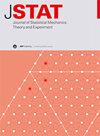偏向运动诱导的相分离:从趋化到交通堵塞
IF 1.9
3区 物理与天体物理
Q2 MECHANICS
Journal of Statistical Mechanics: Theory and Experiment
Pub Date : 2024-04-30
DOI:10.1088/1742-5468/ad3a5e
引用次数: 0
摘要
我们提出了一种活跃粒子的一维模型,它介于运动诱导相分离(MIPS)研究中使用的法定量感应模型和单车道高速公路交通流拥堵模型之间。粒子的目标速度与密度大小有关,其方向以有限速率翻转,偏向右侧移动。两个关键参数是偏差和速度松弛时间。众所周知,在这种模型中,MIPS 发生在零偏置和零松弛时间(过阻尼动力学)的情况下,而无速度反转的全偏置运动则是高速公路上的交通流模型。通过数值模拟和从微观动力学推导出的连续方程,我们发现在由偏置和速度松弛时间定义的相图中,从通常的 MIPS 到拥堵的交通流之间存在单一的相分离状态。然而,在完全偏置的情况下,惯性是观察相分离的关键,如果不同时考虑惯性和翻滚,MIPS 和拥挤的交通流似乎是不同的现象。我们描述了密集相的速度特征,通常 MIPS 中密集相的速度是静态的,而在交通拥堵时密集相的速度会向后移动。我们还发现,在存在偏压的情况下,相图变得更加丰富,在偏压或弛豫率阈值之上会出现相分离和微相分离之间的额外过渡。本文章由计算机程序翻译,如有差异,请以英文原文为准。
Biased motility-induced phase separation: from chemotaxis to traffic jams
We propose a one-dimensional model of active particles interpolating between quorum sensing models used in the study of motility-induced phase separation (MIPS) and models of congestion of traffic flow on a single-lane highway. Particles have a target velocity with a density-dependent magnitude and a direction that flips with a finite rate that is biased toward moving right. Two key parameters are the bias and the speed relaxation time. MIPS is known to occur in such models at zero bias and zero relaxation time (overdamped dynamics), while a fully biased motion with no velocity reversal models traffic flow on a highway. Using both numerical simulations and continuum equations derived from the microscopic dynamics, we show that a single phase-separated state extends from the usual MIPS to congested traffic flow in the phase diagram defined by the bias and the speed relaxation time. However, in the fully biased case, inertia is essential to observe phase separation, making MIPS and congested traffic flow seemingly different phenomena if not simultaneously considering inertia and tumbling. We characterize the velocity of the dense phase, which is static for usual MIPS and moves backward in traffic congestion. We also find that in presence of bias, the phase diagram becomes richer, with an additional transition between phase separation and a microphase separation that is seen above a threshold bias or relaxation rate.
求助全文
通过发布文献求助,成功后即可免费获取论文全文。
去求助
来源期刊
CiteScore
4.50
自引率
12.50%
发文量
210
审稿时长
1.0 months
期刊介绍:
JSTAT is targeted to a broad community interested in different aspects of statistical physics, which are roughly defined by the fields represented in the conferences called ''Statistical Physics''. Submissions from experimentalists working on all the topics which have some ''connection to statistical physics are also strongly encouraged.
The journal covers different topics which correspond to the following keyword sections.
1. Quantum statistical physics, condensed matter, integrable systems
Scientific Directors: Eduardo Fradkin and Giuseppe Mussardo
2. Classical statistical mechanics, equilibrium and non-equilibrium
Scientific Directors: David Mukamel, Matteo Marsili and Giuseppe Mussardo
3. Disordered systems, classical and quantum
Scientific Directors: Eduardo Fradkin and Riccardo Zecchina
4. Interdisciplinary statistical mechanics
Scientific Directors: Matteo Marsili and Riccardo Zecchina
5. Biological modelling and information
Scientific Directors: Matteo Marsili, William Bialek and Riccardo Zecchina

 求助内容:
求助内容: 应助结果提醒方式:
应助结果提醒方式:


